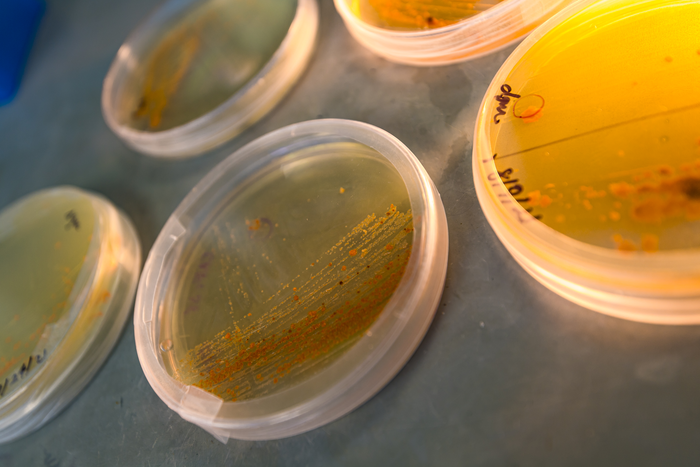Years of laboratory work have revealed how a marine bacterium makes a potent anticancer molecule called salinosporamide. Researchers at UC San Diego’s Scripps Institution of Oceanography unravelled the enzyme-driven process that activates the molecule, and found that a ketosynthase (KS) enzyme called SalC assembles what the team calls the salinosporamide anticancer “warhead.” Salinosporamide A (also known as marizomib) is a potent 20S proteasome inhibitor that is already undergoing Phase III clinical trials to treat glioblastoma.
The newly reported findings solve a nearly 20-year riddle about how the marine bacterium makes the warhead that is unique to salinosporamide, and opens the door to the development of novel approaches to manufacturing new anticancer agents.
“Now that scientists understand how this enzyme makes the salinosporamide A warhead, that discovery could be used in the future to use enzymes to produce other types of salinosporamides that could attack not only cancer but diseases of the immune system and infections caused by parasites,” said Bradley Moore, PhD, a distinguished professor at Scripps Oceanography and the Skaggs School of Pharmacy and Pharmaceutical Sciences, and senior author of the team’s published paper in Nature Chemical Biology.
Scripps graduate student Katherine Bauman is lead author of the report “Enzymatic assembly of the salinosporamide γ-lactam-β-lactone anticancer warhead,” which explains the salinosporamide assembly process. In their paper the authors concluded, “Almost 18 years after its initial discovery, and four years after entering Phase III clinical trials, a key mystery in the biosynthesis of salinosporamide A has finally been revealed. Using biochemical and structural data, we identified and characterized an unusual KS responsible for performing previously unprecedented biochemistry.”
Salinosporamide A, also known as marizomib, was originally isolated from the obligate marine actinomycete Salinispora tropica. The molecule is presently undergoing Phase III clinical trials for the treatment of glioblastoma, an aggressive form of brain cancer with a poor prognosis and few therapeutic options, the authors noted. And despite the discovery of natural analogs of the compound, as well as extensive efforts to generate derivatives via chemical synthesis and mutasynthesis, it is the originally discovered natural product itself that entered clinical trials.
The molecule has a small but complex ring structure. It starts as a linear molecule that folds into a more complex circular shape. “Salinosporamide A is characterized by a complex and densely functionalized γ-lactam-β-lactone bicyclic warhead, the assembly of which has long remained a biosynthetic mystery,” the investigators stated. This compact γ-lactam-β-lactone pharmacophore is “distinct among proteasome inhibitors,” including the FDA-approved drugs bortezomib, carfilzomib, and ixazomib. “Marizomib is “fundamentally different” from approved proteasome inhibitors, the investigators noted, as it is the only non-peptidic compound in advanced clinical trials and targets all three catalytic subunits of the human 20S proteasome.” Moreover, they noted, and unlike other proteasome inhibitors, salinosporamide crosses the blood–brain barrier. And it’s this ability that accounts for its progress in clinical trials for glioblastoma, Moore suggested. Some of the clinical trials over the course of the drug’s development took place at Moores Cancer Center at UC San Diego Health.

Other salinosporamides have been isolated, but salinosporamide A has features that the others lack—including biological activity that makes it hazardous to cancer cells. A big question for Bauman was to find out how many enzymes were responsible for folding the molecule into its active shape. “I would have bet money on more than one. In the end, it was just SalC. That was surprising,” she said. “The way nature makes it is beautifully simple,” Moore added. “We as chemists can’t do what nature has done to make this molecule, but nature does it with a single enzyme.”
Bauman, together with Percival Yang-Ting Chen, PhD, of Morphic Therapeutics, and Daniella Trivella, PhD, of Brazil’s National Center for Research in Energy and Materials, determined the molecular structure of SalC. To do this they used Advanced Light Source, a powerful particle accelerator that generates X-ray light, at the U.S. Department of Energy’s Lawrence Berkeley National Laboratory.
The ketosynthase enzyme is common in biology; it is one that participates in the production of fatty acids in humans and antibiotics such as erythromycin in microbes.“The SalC enzyme performs a reaction very different from a normal ketosynthase,” Bauman said. A normal ketosynthase is an enzyme that helps a molecule form a linear chain. SalC, by contrast, manufactures salinosporamide by forming two complex, reactive, ring structures. A single enzyme can form both of those ring structures that are hard for synthetic chemists to make in the lab.
Armed with this information scientists now can mutate the enzyme until they find forms that show promise for suppressing various types of disease. “This has been a very challenging 10-year project,” said Moore, who is Bauman’s advisor. “Kate’s been able to bring together 10 years’ worth of earlier work to get us across the finish line.” The authors further noted, “This discovery establishes the biosynthetic logic of this brain-penetrant drug candidate and provides a clear roadmap for the generation of new KS-based biocatalysts in medicinal chemistry … This work challenges our current understanding of the role of KS enzymes and establishes a basis for future efforts toward streamlined production of a clinically relevant chemotherapeutic.”
“Inhibiting that proteasome makes it a great anticancer agent,” said Bauman, speaking of the protein complex that degrades useless or impaired proteins. But there’s another type of proteasome found in immune cells. What if scientists could devise a slightly different salinosporamide than salinosporamide A? One that poorly inhibits the cancer-prone proteasome but excels at inhibiting the immunoproteasome? Such a salinosporamide could be a highly selective treatment for autoimmune diseases, the type that causes the immune system to turn upon the very body it should protect.
“That’s the idea behind generating some of these other salinosporamides. And access to this enzyme SalC that installs the complicated ring structure opens the door to that in the future,” Bauman said.


